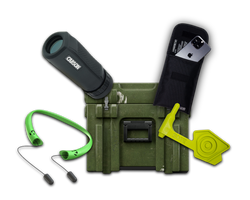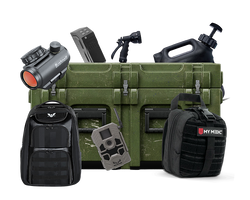What Assault Rifle Does SWAT Use: An In-Depth Look at Tactical Armaments
Table of Contents
- Introduction
- The Evolution of SWAT Weaponry
- The Importance of Training and Tactics
- Community Engagement and the Role of SWAT
- Conclusion
- FAQ
Introduction
When we think of Special Weapons and Tactics (SWAT) teams, images of highly trained officers equipped with advanced weaponry and technology come to mind. The role of these elite units has evolved significantly since their inception, especially in terms of the firearms they use. One of the most critical components of a SWAT team’s arsenal is the assault rifle. But what assault rifle does SWAT use? This question is not just about the firearms themselves; it encompasses the technology, tactics, and training that define modern policing in high-risk scenarios.
The relevance of this topic is heightened in today’s society, where law enforcement faces increasingly complex challenges, including terrorism, armed standoffs, and active shooter situations. SWAT teams are often the first responders to these critical incidents, and their choice of weapon can significantly impact the outcome. This blog post will delve into the various assault rifles utilized by SWAT teams across the United States, examining their specifications, advantages, and the strategic implications of their use.
By the end of this article, you will have a comprehensive understanding of the assault rifles favored by SWAT teams, the factors influencing their selection, and insights into how these choices reflect broader trends in tactical law enforcement. We will explore the evolution of SWAT weaponry, discuss popular models currently in service, and highlight the importance of training and community engagement in the tactical landscape.
The Evolution of SWAT Weaponry
Historical Context
The establishment of SWAT teams in the late 1960s was a response to significant urban unrest and the need for specialized units capable of handling high-stakes situations. Initially, these teams relied on traditional firearms, such as revolvers and shotguns, which were not always adequate for modern threats.
The North Hollywood shootout in 1997 marked a pivotal moment in SWAT history. During this incident, heavily armed robbers outgunned the LAPD, leading to a reevaluation of police armaments and tactics. This event served as a catalyst for many departments to upgrade their weaponry, leading to an increased prevalence of assault rifles in tactical operations.
Transition to Assault Rifles
As SWAT teams faced more sophisticated threats, the transition from traditional firearms to assault rifles became a necessity. The AR-15 platform, specifically the M4 carbine, emerged as the weapon of choice for many units due to its versatility, ease of use, and effectiveness in urban environments.
-
Versatility: Assault rifles like the M4 can be configured for various missions, from close-quarters combat to precision shooting.
-
Stopping Power: Chambered in 5.56mm NATO, these rifles offer a balance of stopping power and manageable recoil, making them suitable for rapid engagement scenarios.
-
Accuracy: With the ability to mount optics and accessories, assault rifles provide superior accuracy compared to traditional sidearms.
Current Trends
Today, many law enforcement agencies have adopted a variety of assault rifles, but the choice often depends on departmental budgets, mission profiles, and available training. The most commonly used models include:
- M4 Carbine
- Colt Commando
- FN SCAR
- SIG MCX
Popular Models in SWAT Operations
-
M4 Carbine: The standard for many SWAT teams, the M4 offers modularity and adaptability. It is lightweight, offers a high rate of fire, and can be customized with various optics and tactical accessories.
-
Colt Commando: Known for its compact design, the Colt Commando is favored for situations requiring maneuverability without sacrificing power.
-
FN SCAR: This rifle is known for its reliability and adaptability, allowing operators to switch between calibers, making it versatile for different mission requirements.
-
SIG MCX: The MCX platform is designed for modularity and can be quickly transformed for different operational needs, making it an attractive option for modern SWAT teams.
The Importance of Training and Tactics
Comprehensive Training Programs
The effectiveness of any weapon system is directly tied to the training its operators receive. SWAT teams undergo rigorous and continuous training to ensure proficiency with their firearms. This includes:
-
Marksmanship: SWAT operators must master various shooting techniques, including precision shooting, rapid engagement, and controlled pairs.
-
Tactical Movement: Operators are trained in moving as a cohesive unit, ensuring safety while engaging threats.
-
Scenario-Based Training: Engaging in realistic training scenarios helps prepare SWAT teams for real-world situations, enhancing decision-making under pressure.
Tactical Considerations
When it comes to utilizing assault rifles, several tactical considerations come into play:
-
Engagement Distance: The effective range of an M4 or similar assault rifle allows SWAT teams to engage threats from a distance, reducing risk to themselves and civilians.
-
Cover and Concealment: Operators must understand how to use their environment effectively, utilizing cover while maintaining visibility and control.
-
Communication: Effective communication within the team is essential for coordinating movements and actions during high-stress situations.
Community Engagement and the Role of SWAT
Building Trust
While SWAT teams are often associated with high-stakes confrontations, they also play a crucial role in community engagement. By fostering relationships with local communities, SWAT units can build trust and understanding, which can be invaluable during critical incidents.
Transparency and Accountability
Communicating openly about the use of assault rifles and the necessity of their presence in the community can help mitigate fears and misconceptions. SWAT teams that actively engage with the community can demystify their operations, enhancing public safety and cooperation.
Conclusion
The question of what assault rifle does SWAT use reflects broader trends in law enforcement and community safety. As threats evolve, so too must the tools and tactics used by those tasked with protecting the public. The M4 carbine, Colt Commando, FN SCAR, and SIG MCX are not merely weapons; they represent a commitment to preparedness and excellence in tactical operations.
Furthermore, the importance of training, communication, and community engagement cannot be overstated. As these elite units continue to adapt to the challenges of modern policing, their role in society becomes increasingly significant.
By understanding the intricacies of SWAT operations and the armaments they employ, we can appreciate the dedication of these professionals and the complexities of law enforcement in today’s world. As we reflect on the evolving landscape of tactical readiness, it is clear that the right equipment, training, and community collaboration are essential for ensuring public safety.
FAQ
What is the standard assault rifle used by most SWAT teams?
Most SWAT teams commonly use the M4 carbine due to its versatility and effectiveness in various tactical scenarios.
Why are assault rifles preferred over traditional firearms?
Assault rifles provide greater stopping power, accuracy, and versatility compared to traditional firearms, making them better suited for high-risk situations.
How does training impact the effectiveness of SWAT teams?
Comprehensive training ensures that SWAT operators are proficient in marksmanship, tactical movement, and decision-making, greatly enhancing their effectiveness during operations.
Are SWAT teams involved in community engagement?
Yes, SWAT teams engage with the community to build trust and understanding, which can be critical during high-stress incidents.
What other equipment do SWAT teams typically use alongside assault rifles?
In addition to assault rifles, SWAT teams often utilize shotguns, sniper rifles, less-lethal weapons, tactical gear, and armored vehicles for various operations.
For those interested in enhancing their own tactical preparedness, consider exploring Crate Club's subscription services for curated tactical gear, survival tools, and equipment. With four tiers ranging from Lieutenant to General, there's a level that suits every tactical enthusiast's needs. Visit Crate Club Subscription Services for more information.
Additionally, check out the Crate Club Shop for an extensive collection of high-quality tactical gear and equipment. Empower yourself with the tools and knowledge to be prepared for any situation.
แบ่งปันบทความนี้



